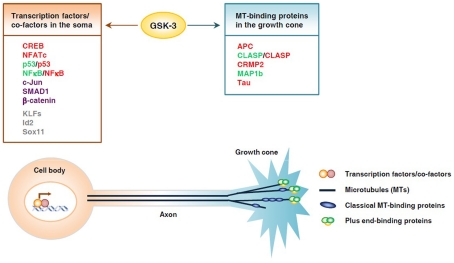Figure 1.
Glycogen synthase kinase 3 controls axon growth by coordinating gene transcription and local microtubule dynamics in the growth cone. GSK3 phosphorylates a number of transcription factors and thereby controls their function and subsequent gene expression, which may play an important part in determining the intrinsic axon growth capacity. GSK3 is also known to phosphorylate several microtubule-binding proteins, which control distinct aspects of microtubule dynamics and assembly, and thereby controls local axon assembly at the axonal growth cone. The final outcome of axon regeneration is determined by the coordination between gene expression and local cytoskeletal assembly at the growth cone. Substrates whose activities are inhibited by GSK3 are depicted in red, those that are activated by GSK3 are depicted in green. Some substrates, such as p53 and NFκB, can be either activated or inhibited upon GSK3 phosphorylation, depending on the context. Substrates that undergo proteasomal degradation when phosphorylated by GSK3 are depicted in purple. Putative substrates are shown in gray.

